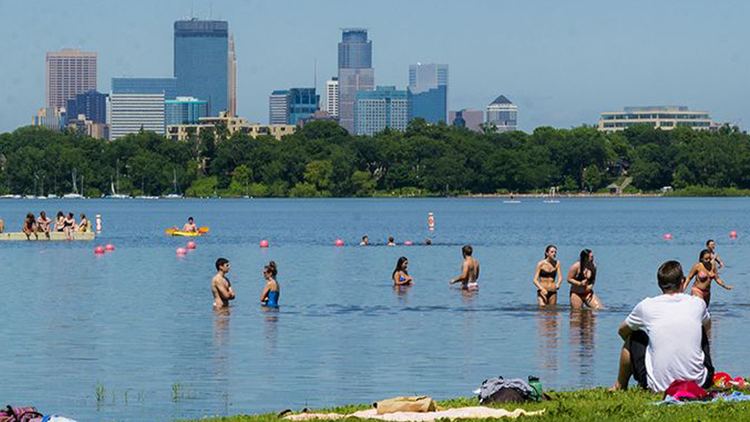Location Minneapolis, Minnesota Surface area 401 acres (1.62 km) Max. depth 87 ft (27 m) Mean depth 25 m | Basin countries United States Average depth 82 ft (25 m) Area 162 ha Inflow source Lake of the Isles | |
 | ||
Similar Lake Harriet, Lake of the Isles, Minnehaha Park, Mill City Museum, The Museum of Russian Art | ||
Peaceful muslim s terrorize lake calhoun mn max bauer
Lake Calhoun (also called Bde Maka Ska) is the largest lake in Minneapolis, Minnesota, and part of the city's Chain of Lakes. Surrounded by city park land and circled by bike and walking trails, it is popular for many outdoor activities. The lake has an area of 401 acres (1.62 km2) and a maximum depth of 87 feet (27 m).
Contents
- Peaceful muslim s terrorize lake calhoun mn max bauer
- Map of Lake Calhoun Minneapolis MN USA
- Pokemongo adventures at lake calhoun and lake harriet
- Lake and surrounding areaEdit
- NameEdit
- FishEdit
- References
Map of Lake Calhoun, Minneapolis, MN, USA
Pokemongo adventures at lake calhoun and lake harriet
Lake and surrounding areaEdit
The lake is part of the Grand Rounds National Scenic Byway, connecting with Lake of the Isles on the northeast, Cedar Lake on the northwest, and Lake Harriet on the south. The trail system has a 3.4-mile (5.5 km) trail around Lake Calhoun for bicyclists and skaters and a 3.2-mile (5.1 km) trail around Lake Calhoun for pedestrians. Both of these trails connect to the larger trail system via connections to Lake of the Isles and Lake Harriet. In addition, the Midtown Greenway Trail is located just north of the lake and Lake Street. The lake itself is popular for canoeing, kayaking, and windsurfing, and it has three swimming beaches.
The three beaches are Calhoun North Beach on the north side of the lake, Calhoun 32nd Beach on the east side and Calhoun Thomas Beach on the south side. There is Lake Calhoun Park and Surrounding park land offers parking, picnicking, volleyball, and athletic fields. It is also home of sailing, hosting the Calhoun Yacht Club, the Lake Calhoun Sailing School, as well as local high school teams and the University of St Thomas Sailing Team.
A plaque on the east side of the lake commemorates the first home built in Minneapolis by Gideon Pond, a missionary, in the 1830s. On the west side is located the Bakken Museum, which is devoted to the study of electricity in life.
NameEdit
The Dakota originally called the lake Mde Maka Ska (modern spelling Bde Maka Ska) meaning White Earth Lake, a name that probably was given by the Ioway who inhabited the area until the 16th century. Another Dakota name for the lake may have been Mde Med'oza, which was the name initially adopted by settlers, either as Lake Medoza or in translation as Loon Lake. The United States Secretary of War, John C. Calhoun, sent the Army to survey the area that would surround Fort Snelling in 1817. Calhoun had also authorized the construction of Fort Snelling, one of the earliest Euro-American settlements in the state. The surveyors renamed the water body "Lake Calhoun" in his honor. The Fort Snelling Military Reservation survey map created by Lt. James L. Thompson in 1839 clearly shows the lake as bearing the name "Calhoun."
Calhoun's legacy as a pro-slavery politician has led critics to question whether he is the best person to be honored. In 2011 the Minneapolis Park and Recreation Board visited the issue. Their legal counsel concluded that the board could not legally change the name, as state law gives that power to the Commissioner of Natural Resources, and then only in the first 40 years after the name was designated. Following the Charleston church shooting in June 2015, a fresh drive to change the name started via an online petition. The Park Board indicated it would look into whether they could change the lake's name through state action, and in fall 2015 added the Dakota name to signage below the official name. On March 22, 2016, an advisory group decided via majority vote to urge the Minnesota Park and Recreation Board to restore the lake's former name.
FishEdit
The lake contains black crappie, bluegill, bowfin, common carp, hybrid sunfish, largemouth bass, northern pike, pumpkinseed, tiger muskellunge, walleye, white sucker, and yellow perch. Some fish consumption guideline restrictions have been placed on the lake's bluegill, crappie, largemouth bass, northern pike, walleye, and white sucker due to mercury and/or PFOS contamination.
In 1991, the then-Minnesota state record tiger muskellunge at 33 pounds 8 ounces was caught in the lake.
